Science & Environment
Yale’s Stephen Roach warns of global volatility, ‘whipsawed’ markets
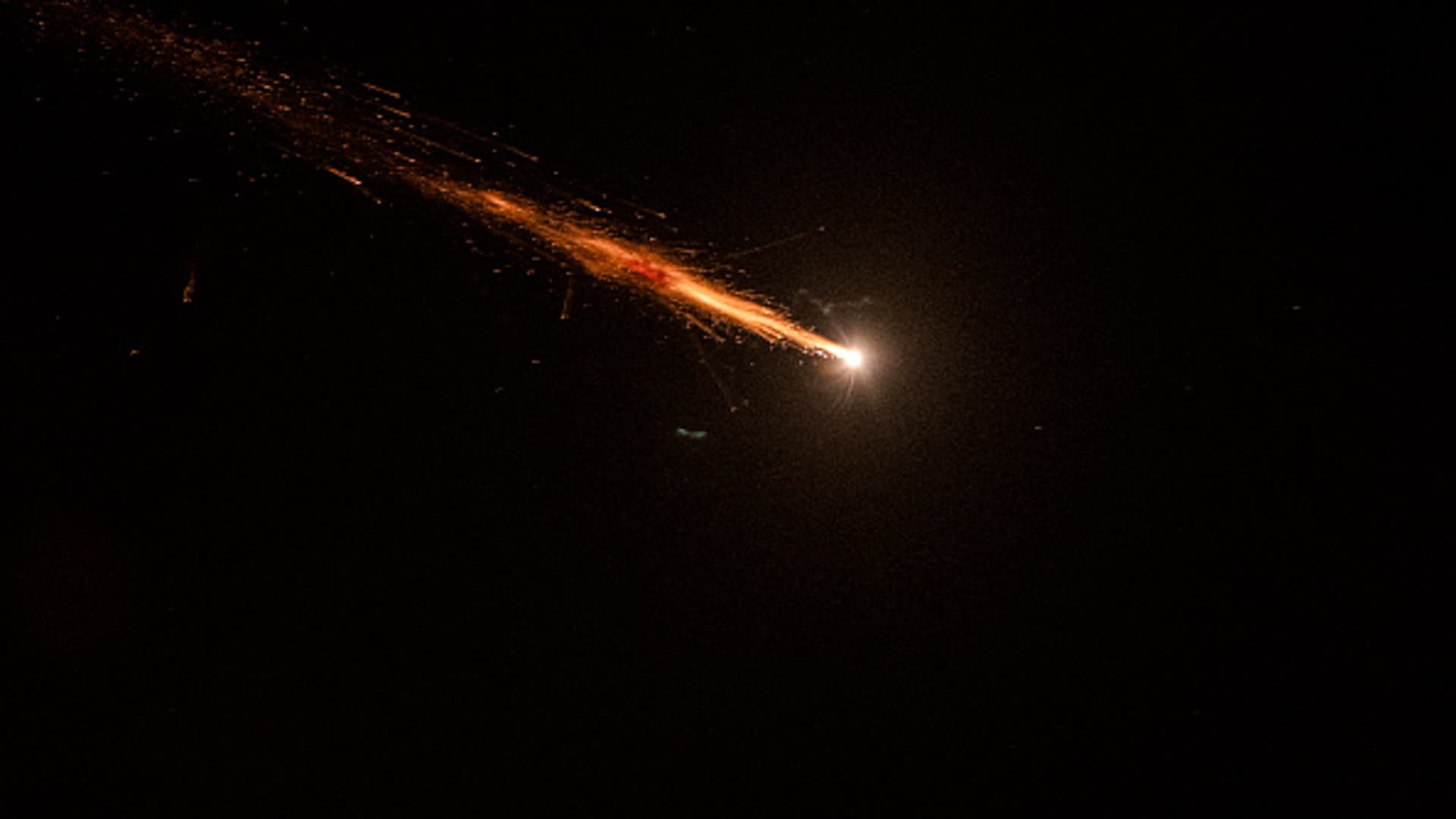
01 October 2024, Israel, Tel Aviv: Missiles launched from Iran are seen in the sky over Tel Aviv.
Ilia Yefimovich/dpa | Picture Alliance | Getty Images
Markets are in danger of being “whipsawed” by the combination of regional conflict in the Middle East and rising unemployment in the United States, says Stephen Roach, senior fellow at Yale Law School’s Paul Tsai China Center.
The conflict in the Middle East escalated on Tuesday, with Iran launching a ballistic missile attack on Israel after its killing of Hezbollah leader Hassan Nasrallah and an Iranian commander in Lebanon.
Most Asian markets fell on Wednesday, tracking losses on Wall Street overnight, as investors fretted over rising tensions in the Middle East.
“The markets really will not know where to turn,” Roach said, adding that conflicts in the Middle East are adding to inflationary risks at a time when global central banks are starting to ease monetary policy.
“We are likely to see significant increases in volatility and markets that really are whipped back and forth dramatically,” Roach told CNBC’s “Squawk Box Asia” on Wednesday.
Oil market impact
The Israel Defense Forces said its troops had started launching new strikes against Hezbollah targets in Lebanon in response to Iran’s missile attack Tuesday night.
It remains to be seen whether there will be lasting effects on inflation, said Stephen Stanley, chief economist at Santander, adding that the oil market will be “affected more significantly” if the tension escalates.

Iran is the third-largest producer among the Organization of the Petroleum Exporting Countries, pumping out nearly four million barrels of oil per day, according to the Energy Information Administration. Oil prices had jumped over 5% after the missile strike before tapering to a 2% climb.
Outlook for interest rates
The Israeli response to Iran’s attacks “might throw the Fed’s 25-basis-point rate cut off track,” said Kelvin Tay, regional chief investment officer at UBS Global Wealth Management.
The U.S. Federal Reserve projected cutting interest rates by another half point over the next two policy meetings this year, according to the central bank’s so-called dot plot from the September meeting.
Traders are also looking to U.S. payroll data on Friday for more indications on the state of the economy after the U.S. Federal Reserve’s jumbo rate cut in September. A higher-than-expected unemployment rate could prompt the Fed to accelerate the easing cycle to achieve a soft landing.
The unemployment rate in September is expected to come in at 4.2%, according to data of a Reuters poll on LSEG, unchanged from the August figure. The unemployment rate had jumped to near a three-year high of 4.3% in July, a dramatic rise from the five-decade low of 3.4% in April 2023.

Another factor that could affect the Fed’s rate-cutting pace is how long dockworkers’ strikes at the U.S. East and Gulf coasts will last, Tay said.
Dockworkers at ports stretching from Maine to Texas have gone on a large-scale strike over disputes on wages and threats from automation. It’s expected to disrupt global supply chains and has halted the flow of nearly half of the country’s ocean shipping, Reuters reported.
“Any disruption of the port, any work stoppage at the port is going to have a very significant economic consequence and very quickly,” said Peter Tirschwell of S&P Global Market Intelligence, warning that “the longer this goes on, the quicker the economic damage will mount.”
Science & Environment
Soft landing hit by minor turbulence
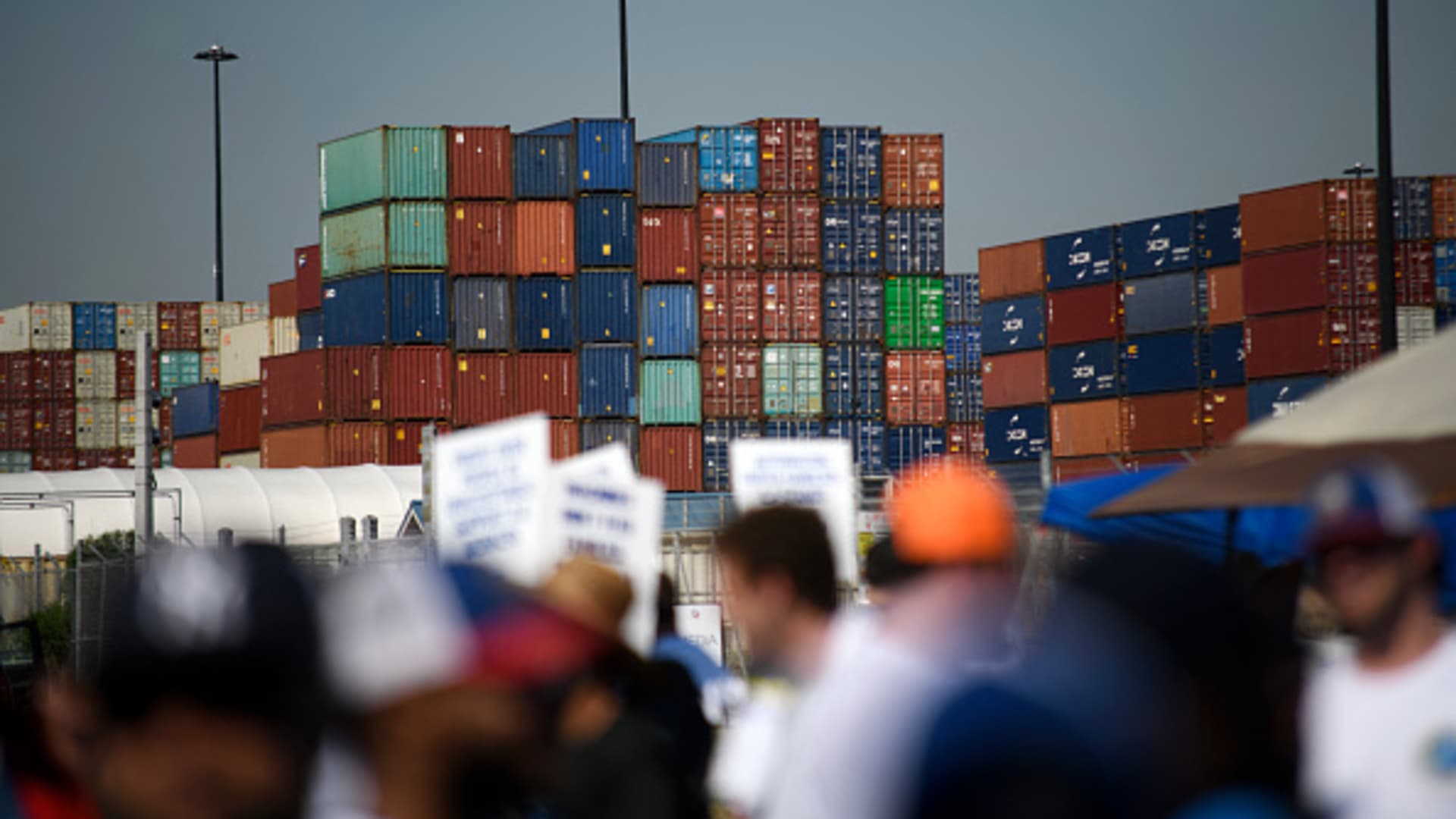
Dockworkers strike at the Bayport Container Terminal in Seabrook, Texas, on October 1, 2024.
Mark Felix | Afp | Getty Images
This report is from today’s CNBC Daily Open, our international markets newsletter. CNBC Daily Open brings investors up to speed on everything they need to know, no matter where they are. Like what you see? You can subscribe here.
What you need to know today
U.S. stocks shaken as Hong Kong market rallies
U.S. stocks fell on fears over growing geopolitical tensions. The S&P 500 slipped 0.93%, the Dow Jones Industrial Average lost 0.41% and the Nasdaq Composite retreated 1.53%. Hong Kong’s Hang Seng index popped around 5%, propelled by the year’s strongest rally in Hong Kong-listed Chinese property stocks.
Escalating Middle East conflict
Prices of WTI and Brent oil rose around 1.6% during Asian trading hours as conflict escalated in the Middle East. On Tuesday, Israel began a ground offensive in Lebanon and Iran launched a ballistic missile attack on Israel. Analysts told CNBC there’s a chance Israel will hit Iran’s oil infrastructure, which could cause oil to spike to more than $100 a barrel.
Widespread effect of port strike
Members of the International Longshoremen’s Association started striking Tuesday, halting activity at U.S. East Coast and Gulf Coast ports, which stretch from Maine to Texas. If the strike drags on, global supply chains and the economy could take a beating. That runs the risk of causing inflation to flare up again.
Risk-off on crypto
Amid this cautious atmosphere, investors pulled back from cryptocurrency. Bitcoin is currently trading at $61,407.21, down from nearly $66,000 on Sunday. Crypto-related companies also struggled on Tuesday. Coinbase tumbled 7.4% and fell around 1% in extended trading.
[PRO] Fund manager’s worst-performing stock
Ranmore Global Equity Fund managed to beat the S&P the past two years. But there have been slip-ups as well. Its fund manager shares with CNBC the worst-performing stock he’s picked: why he bought it, what went wrong and the lessons he learned.
The bottom line
Just when the coast appeared clear, geopolitical tensions and potential supply chain snarl-ups threaten to turn the soft-landing trajectory into a bumpy one.
Port workers along the U.S. East Coast and Gulf Coast started striking Tuesday. At a port in the New York-New Jersey area, around 100,000 shipping containers “are literally in limbo in the port,” said New York Governor Kathy Hochul.
“A disruption of a week or two will create some backlogs but the broader consequences will be minimal,” said Adam Kamins, economist at Moody’s Analytics.
Should the work stoppage go on for longer, however, “you’re running into businesses that have real shortages and, yeah, they’ll absolutely have to raise those prices,” said Christopher Ball, economics professor at Quinnipiac University.
(Fans of Rao’s pasta sauce need not fear, for now. Piper Sandler wrote that Campbell Soup, which bought Rao’s earlier this year, “has healthy levels of inventory on hand.”)
Meanwhile, oil prices spiked as markets feared Iran, a member of OPEC, would be dragged into a larger conflict in the Middle East. Higher oil prices pose a risk to inflation resurging, or at least slowing less than everyone is hoping for.
With those fears and uncertainties swirling, the Cboe Volatility Index, known as Wall Street’s fear gauge, climbed to 19.3 on Tuesday. It closed at 15.4 a week ago. Major U.S. indexes fell, with the tech-heavy Nasdaq suffering the most as megacaps like Tesla, Nvidia and Apple dropped.
It’s just the first days of the port strike and flare-up in Middle East tensions, however. The classic safe-haven trades, like bonds, gold and the U.S. dollar, aren’t showing up in the prices of those assets yet, noted CNBC’s Steve Liesman.
The best-case scenario would be that recent events are just minor turbulence on the way to a soft landing.
– CNBC’s Jeff Cox, Fred Imbert, Lori Ann LaRocco, Sean Conlon, Alex Harring and Brian Evans contributed to this story.
Science & Environment
Oil watchers now see a real threat of supply disruptions after latest Iran-Israel escalation
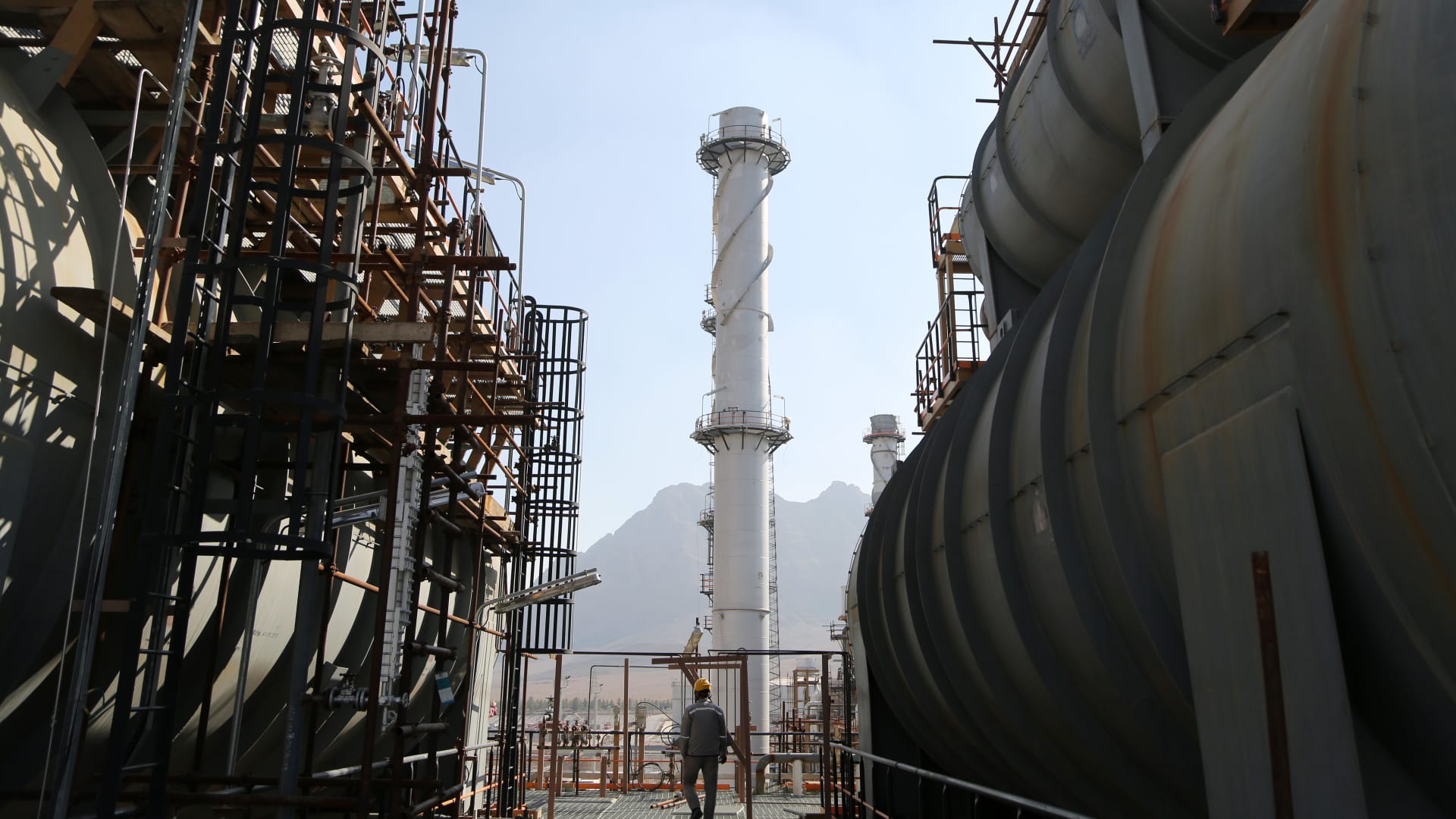
A general view of Isfahan Refinery, one of the largest refineries in Iran and is considered as the first refinery in the country in terms of diversity of petroleum products in Isfahan, Iran on November 08, 2023.
Fatemeh Bahrami | Anadolu | Getty Images
Oil watchers are now seeing a genuine threat to crude supplies after Iran launched a ballistic missile attack on Israel, escalating conflict in the Middle East.
Iran on Tuesday launched the strike on Israel in retaliation for its recent killing of Hezbollah leader Hassan Nasrallah and an Iranian commander in Lebanon.
Iranian oil infrastructure may soon become a target for Israel as it considers a countermove, analysts told CNBC.
“The Middle East conflict may finally impact oil supply,” said Saul Kavonic, senior energy analyst at MST Marquee. “The scope for a material disruption to oil supply is now imminent.”
These latest developments could be a gamechanger, after a prolonged period of “geopolitical risk fatigue” during which traders brushed off threats of oil supply disruptions stemming from the situation in the Middle East as well as Ukraine, he said.
Up to 4% of global oil supply is at risk as the conflict now directly envelopes Iran, and an attack or tighter sanctions could send prices to $100 per barrel again, Kavonic added.

Oil prices year-to-date
Iran’s latest missile attack followed Israel’s deployment of ground troops into southern Lebanon, intensifying its offensive against Hezbollah, the Iran-backed militant group. Most of the 200 missiles launched were intercepted by Israeli and U.S. defenses, and there were no reported fatalities in Israel as a result of the attack.
The attack came on the heels of Israel‘s deployment of ground forces into south Lebanon, escalating its offensive on Hezbollah, the Iran-backed militant group.
Oil prices gained over 5% in the previous session following the missile strike, before tapering to a 2% climb. Global benchmark Brent is now trading 1.44% higher at $74.62 a barrel, while U.S. West Texas Intermediate futures rose 1.62% to $70.95 per barrel.
As Israel turns from Gaza to Lebanon and Iran, the war is entering a new and more energy-related phase.
Bob McNally
President of Rapidan Energy Group
Since the armed Israel-Hamas conflict started Oct. 7 of last year, disruptions to the oil market has been limited. The oil market also remains under pressure as increased production from the U.S. add to the supply picture, and sputtering Chinese demand have depressed prices, said Andy Lipow, president at Lipow Oil Associates.
Iran is the third largest producer among the Organization of the Petroleum Exporting Countries, producing almost four million barrels of oil per day, according to data from the Energy Information Administration.
New phase of the war?
Other analysts echoed Kavonic’s warning.
“As Israel turns from Gaza to Lebanon and Iran, the war is entering a new and more energy-related phase,” Bob McNally, president of Rapidan Energy Group, told CNBC, adding that he expects Israel’s retaliation for the missile attack to be “disproportionately large.”
“It’s going to get worse before it gets better,” he said.
Ross Schaap, head of research at GeoQuant, which leverages structural and high-frequency data to generate political risk scores, said that the organization’s risk analysis model of the Israel-Iran conflict, which has remained in three standard deviations of the average trend over the past 12 years, saw a significant spike after the latest missile strikes.
These results indicate that “much bigger events” are expected, said Schaap said.
Josh Young, CIO of Bison Interests, who is similarly observing an increasing likelihood of a potential strike on Iranian oil infrastructure oil supply disruption, said that this marks a “significant escalation” by Iran.
Should Iranian exports go offline due to an attack, Young predicts that oil prices will surge to more than $100 per barrel.
Science & Environment
Bethany Beach firefly could be first lightning bug added to federal endangered species list

The Bethany Beach firefly is in danger of flickering out and becoming endangered, the U.S. Fish and Wildlife Service said Monday.
The firefly, found in coastal Delaware, Maryland and Virginia, is one of around 170 firefly species in the U.S. The species is already considered critically endangered by the International Union for Conservation of Nature and the Fish and Wildlife Service said it’s under consideration for listing under the Endangered Species Act.
It’s the first firefly species to be considered for protections under the act, according to a Fish and Wildlife Service spokesperson. If the species is listed, then federal agencies will be required to ensure their actions are unlikely to jeopardize the Bethany Beach firefly.
There are currently more than 1,300 species listed as either endangered or threatened in the U.S. under the 1973 act.
The Bethany Beach firefly is not the only type of firefly at risk; about 10% of the firefly species in the U.S. are not doing well, Sara Lewis, author of “Silent Sparks: The Wondrous World of Fireflies,” told CBS News earlier this year. Some of the lightning bug species most vulnerable to extinction need very specific habitats to survive.
The Bethany Beach firefly, for instance, lives only in swales — low-lying freshwater marsh areas near coastal dunes, according to the Fish and Wildlife Service. Climate change is affecting the firefly habitat and around 76-95% of swales could be lost to high-tide flooding by 2100, according to climate models.
The firefly species also faces threats from development, light pollution, recreation, grazing by ponies, the use of pesticides and invasive plant species.
Light pollution is a threat for a variety of fireflies because it can prevent male and female fireflies from finding each other so they can mate, reducing the population of the future generations of fireflies.
“Love can be hard to find for even the brightest of fireflies,” according to the Fish and Wildlife Service. “Even the interfering light of a full moon can outshine their visual morse code, making it impossible for males and females to recognize each other. Light pollution from towns, factories and roads have been seriously killing the buzz for these insects”
Candace Fallon, senior conservation biologist at the Xerces Society for Invertebrate Conservation, advises being conscientious of fireflies when taking care of lawns. She previously told CBS News that she suggests mowing less often or leaving the grass taller as a way to protect fireflies.
The advice applies year round, not just in the spring and summer when flashes of light are visible.
“So many just people just think about fireflies when they’re these flashing adults for a few weeks in the summer, but the reality is that they’re present all year long, we’re just not noticing them or seeing them,” Fallon said.
Science & Environment
Saudi Arabia slashes growth forecasts, sees wider budget deficits
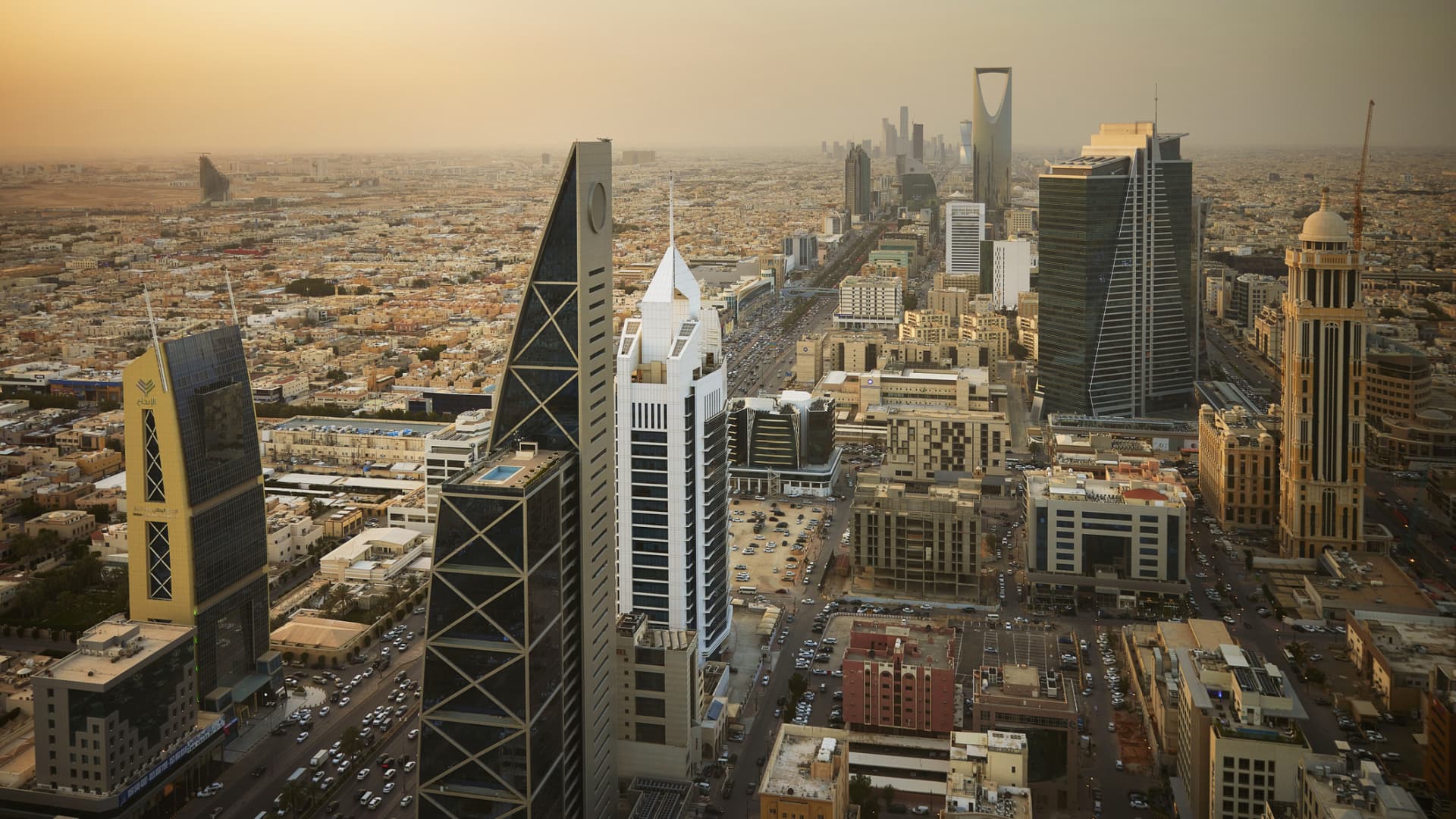
Riyadh, Saudi Arabia.
Xavierarnau | E+ | Getty Images
Saudi Arabia cut its growth forecasts and raised its budget deficit estimates for the fiscal years 2024 to 2026, looking ahead to a period of higher spending and lower projected oil revenues.
Real gross domestic product is now expected to grow 0.8% this year, a dramatic drop from a previous estimate of 4.4%, according to the latest pre-budget report published by the Ministry of Finance on Monday. The GDP growth projection for 2025 has also been cut from a previous estimate of 5.7% to 4.6%; while the outlook for 2026 has been trimmed from 5.1% to 3.5%.
“The FY2025 budget highlights the Kingdom’s commitment to accelerate the regulatory and structural reforms, as well as the development of policies,” the pre-budget report read. “It also focuses on transformative spending to promote sustainable economic growth, improve social development, and enhance quality of life.”
The latest report further emphasized the Saudi government’s plans to deploy sovereign and development funds “for capital investment while empowering both the private and non-profit sectors to foster growth and prosperity.”
Saudi authorities also expect that the budget will remain in deficit for the next several years, as the kingdom prioritizes spending to achieve the targets of its Vision 2030 plan to modernize and diversify the heavily oil-dependent Saudi economy.
The Finance Ministry projected a wider budget shortfall of about 2.9% of GDP for 2024, compared with a previous projection of 1.9% for the year. It predicted deficits of 2.3% and 2.9% in 2025 and 2026, respectively, also wider than previous estimates.

Saudi Arabia’s fiscal breakeven oil price — what it needs a barrel of crude to cost in order to balance its government budget — has increased in recent months and years and may well rise higher along with spending increases.
The IMF’s latest forecast released in April put that fiscal breakeven figure at $96.20 for 2024, marking a roughly 19% increase on the year before. The figure is also about 36% higher than the current price of a barrel of Brent crude, which was trading at around $70.70 as of Tuesday afternoon.
Oil prices are expected to remain subdued at least in the medium-term amid slowing demand and increased supply globally.
Saudi Arabia is hosting major international events that will require steep spending — like the World Cup 2034 and Expo 2030 — as well as building out multi-trillion dollar megaprojects like Neom, which is backed by the kingdom’s mammoth sovereign wealth fund, the Public Investment Fund.

“Saudi Arabia’s GDP dances to the rhythm of oil, and with recent data from the Ministry of Finance, it’s clear that as oil gushes, so does the economy,” Tarik Solomon, chairman emeritus at the American Chamber of Commerce in Saudi Arabia, told CNBC. “But when the wells slow, so does the growth.”
Saudi Arabia’s public debt has grown from around 3% of its GDP in the 2010s to roughly 28% today, according to the International Monetary Fund — a huge jump, but still low by international standards. Public debt in EU countries, for instance, averages 82%. In the U.S. in 2023, that figure was 123%.
Its relatively low debt level and high credit rating makes it easier for Saudi Arabia to take on more debt as it needs to. The kingdom has also rolled out a series of reforms to boost and de-risk foreign investment and diversify revenue streams. While the country’s economy has contracted for the last consecutive four quarters, non-oil economic activity grew 4.4% in the second quarter year-on-year, up 3.4% in the previous quarter.

Science & Environment
Jim Cramer says he’s not buying the negativity on Disney — here’s why he is sticking around
Science & Environment
PayPal CEO Alex Chriss first year praised by Wall Street, stock pop Q3

Alex Chriss, CEO of PayPal Inc.
Courtesy: PayPal
In January, about a hundred days into his job as PayPal CEO, Alex Chriss told CNBC’s David Faber that the payments company hadn’t had much to celebrate in recent years. But Chriss confidently said he was prepared to “shock the world.”
“I love being an underdog,” Chriss said in an interview on “Squawk on the Street,” from the floor of the New York Stock Exchange. He was responding to a question about a recent spate of analyst downgrades.
Dan Dolev of Mizuho Securities was among the skeptics. He cut his rating to the equivalent of a hold on Jan. 16, the day before Chriss’ CNBC appearance, headlining his report, “PayPal faces competitive pressure from ‘A’ to ‘Z.’” The A was for Apple Pay, and the Z represented payments app Zelle, a money transfer service jointly owned by seven of the top U.S. banks.
A few weeks later, PayPal issued weak guidance in its fourth-quarter earnings report, knocking the stock down 11% and justifying Dolev’s concerns.
PayPal appeared to be in deep trouble. Its market cap was down more than 80% since peaking in mid-2021. The company had just cut 9% of it workforce, about 2,500 jobs, and was mired in single-digit growth. Analysts across Wall Street saw rising competition and a declining take rate, or the percentage of revenue PayPal keeps from each transaction.
Fast forward to today, and the picture is dramatically brighter for the 26-year-old Silicon Valley company and its 47-year-old CEO.
Chriss hit his one-year anniversary at the helm on Friday. In the third quarter, which ended on Monday, PayPal shares jumped 34%, their biggest quarterly rally since mid-2020, when the early days of the Covid pandemic fueled a surge in online shopping. It was the first time in eight quarters that PayPal outperformed the Nasdaq, which gained just 2.6% in the past three months.

Dolev bolstered his rating back to a buy in May. In July, the company lifted its full-year profit forecast for a second time and increased share repurchases. Chriss said in the earnings release that the company was now “operating from a position of strength.” The stock rose almost 9%, its best day since late 2022.
“I think he’s been nothing but a phenomenal success story so far,” Dolev said. “The news flow has been out of this world amazing, in terms of the way they manage expectations.”
Susquehanna’s James Friedman lifted his rating on PayPal to a buy in early July. He said Chriss was “setting the bar high” with his comments on CNBC, but said he’s been delivering on his bold promise to shareholders.
“You know how he shocked the world?” Friedman said. “He actually beat his numbers.”
Much of Chriss’ early success has been tied to improved transaction margins and better monetization of key acquisitions like Braintree, which is used by Meta for credit card processing, and payments app Venmo, which is becoming more popular with businesses.
Having cut a lot of the fat in the organization and with a renewed focus on profitability, Chriss has finally sparked some excitement on Wall Street after replacing Dan Schulman, who retired following almost a decade as CEO.
“It was time for some new blood at PayPal,” said Dana Stalder, a startup investor at venture firm Matrix Partners who served as PayPal’s commercial chief from 2004 to 2008. “He’s made a lot of changes very quickly, and I think he has substantially increased the focus on the consumer, which is the right thing.”
‘Wholesale changes’ in leadership
Now comes the harder part — reigniting growth.
Analysts are projecting roughly 6% revenue growth when PayPal reports third-quarter results in about a month, according to LSEG. For the fourth quarter, they expect growth of 5.5%. Sales are only expected to get marginally stronger in 2024, with analysts expecting growth of under 8% for the full year.
PayPal didn’t make Chriss available for an interview for this story.
In the July earnings call, Chriss said of the firm’s next steps that “while change takes time and we still have much work ahead of us, we are well positioned today, have the right leadership in place and are moving full steam ahead.”
Chriss, who spent 19 years at tax software provider Intuit prior to joining PayPal, took little time before he started overhauling the management team. In November, he brought in Isabel Cruz from Walmart as chief people officer, Michelle Gill from Intuit to run a new small business and financial services group, Diego Scotti from Verizon to oversee the consumer group as well as marketing and communications, and Jamie Miller from EY as CFO.
“He has turned over, from what I can tell, the vast majority of the leadership team,” Stalder said. “It’s been wholesale changes.”
Early in his tenure, Chriss publicly identified some of the reasons, in his view, that PayPal had been struggling to find its footing. He highlighted an overly aggressive strategy of expansion through deal making.
“We have done too many acquisitions over the last few years, and we’ve been defocused,” Chriss said in the January interview with Faber. “It was one of the things I noticed when I came in 100 days ago.”
Chriss added that the company had narrowed down its priorities to five key things, “all focused on profitable growth.”
The most important metric to fix, he said, was transaction margin dollars, which is how the company gauges the profitability of its core business. Among Chriss’ strategies to address the deteriorating margin was to offer merchants increased value-added services, such as connecting a couple of data points at checkout to drive down the rate of cart abandonment.
He said in January that 35 million merchants use PayPal and “when we improve their conversion rate, it improves their business, it improves our bottom line.”
PayPal noted to shareholders in its latest earnings report that its branded checkout, along with Braintree and Venmo, helped the company achieve its highest growth rate in transaction margin dollars since 2021. Overall transaction margin dollars increased 8% to $3.6 billion.
Susquehanna’s Friedman says a career at Intuit is the perfect training ground for learning how to mastermind a stock recovery. Speaking to executives there is like “talking to a dashboard,” he said.
“The source code to engineer a higher stock is profitability,” Friedman said. Chriss “really boils down his management style to the things that count” and “reducing what’s irrelevant,” he added.
With Venmo, the goal is to turn one of the most popular choices for money transfer from a strictly consumer app, which has no transaction fees, to a product for merchants. DoorDash, Starbucks and Ticketmaster are among businesses now accepting Venmo as one way that consumers can pay.
Singing at the gas pump
Getting competitive at the point-of-sale is another big priority. That’s led PayPal to Will Ferrell.
The company launched a national campaign last month for PayPal Everywhere, offering 5% cash back for using a PayPal debit card within the mobile app. Ferrell, the pitchman, can be seen in a commercial using the PayPal app to buy lemonade and gas, while singing a parody of Fleetwood Mac’s “Everywhere.”
Stalder says PayPal is way behind Apple and Google, which own the dominant smartphone operating systems with their own embedded digital wallets.
“PayPal has been stuck because it’s less convenient than the mobile wallets, number one,” Stalder said. “And number two, it hasn’t worked offline.”
But Stalder sees a real opportunity for PayPal, in part because Apple has just opened the Secure Element on iOS so that other developers can more easily use the phone for contactless payments, putting them on a more equal plane with Apple Pay.
That development allows PayPal to “ride the mobile wallet rails for the first time and make some real headway in offline payments,” Stalder said.
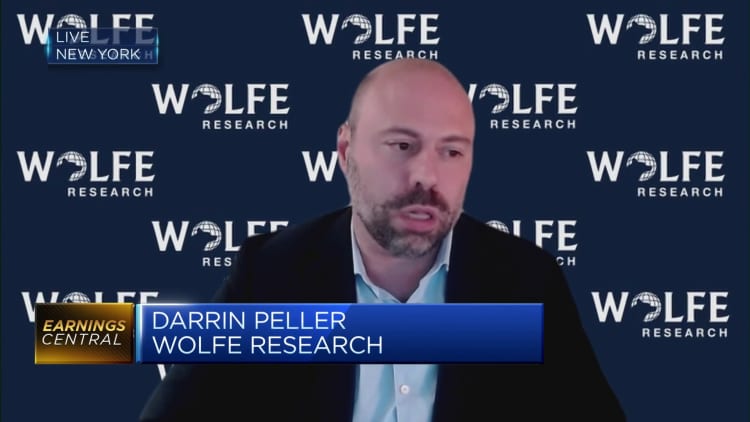
PayPal’s other point-of-sale effort is called Fastlane, a one-click payment option for online sales that can go head-to-head with Apple Pay and Shop Pay by Shopify. In August, fintech platform Adyen made Fastlane available to businesses in the U.S., and said it plans to expand the offering globally in the future.
Chriss told investors on the earnings call that the company is urgently pushing to meet the holiday rush.
“We need to get it on as many platforms as we can so that small businesses in particular can just one-click a button and turn it on for the holidays,” Chriss said. “We’re working with many of our large enterprises who want access to this before the holidays as well.”
‘No drama’
Chriss’ long history at Intuit gave him an intimate understanding of the expansive world of small- and medium-sized businesses. That experience could be crucial as PayPal targets SMBs with its various payment and checkout options.
Sanjay Sakhrani, an analyst at KBW, said going further down market allows PayPal to command better economics because there’s so much more competition when going after enterprises.
“To the extent that they can broaden their reach there, I think that could be quite lucrative,” said Sakhrani, who has a buy rating on the stock.
Chriss calls SMBs an “untapped opportunity for us,” adding on the earnings call that those companies don’t want to “piece together 17 different solutions.”
“Small businesses are – they’re fighting for every customer,” Chriss said in July. “They need to be able to find customers. They need to be able to engage with customers, convert them, and then reengage with them.”
Venture capitalist Oren Zeev has seen Chriss work with small businesses in another capacity. They served together on the board of home design startup Houzz, whose customers include a lot of architects and contractors.
“He obviously brought a lot to the table with his vast experience with small businesses,” Zeev said. As a communicator, Zeev described Chriss as “no drama” and “respected by everyone.”
While he’s quickly captured the respect of investors, who have lifted PayPal’s market cap by over $20 billion in the year since Chriss started, there’s a lot more to do.
The stock remains about 75% below its record high. Sakhrani says shareholders are “anxiously awaiting his multiple-year outlook” as opposed to just “trying to fix some of the stuff that was broken.”
“There’s going to be some pressure at some point in time, in the near future, for more definition around that,” Sakhrani said.
Chriss, for his part, isn’t declaring victory.
“Our teams are moving with urgency, excited about our innovation and focused on execution,” he said on the second-quarter earnings call. “We are still early in our transformation and while pleased with our progress in many areas, we know there is much more we can do and with greater speed.”
WATCH: PayPal’s crypto lead on allowing merchants to buy and sell virtual assets

-

 Womens Workouts1 week ago
Womens Workouts1 week ago3 Day Full Body Women’s Dumbbell Only Workout
-

 Technology2 weeks ago
Technology2 weeks agoWould-be reality TV contestants ‘not looking real’
-

 Science & Environment2 weeks ago
Science & Environment2 weeks ago‘Running of the bulls’ festival crowds move like charged particles
-

 Science & Environment2 weeks ago
Science & Environment2 weeks agoHyperelastic gel is one of the stretchiest materials known to science
-

 Science & Environment2 weeks ago
Science & Environment2 weeks agoMaxwell’s demon charges quantum batteries inside of a quantum computer
-

 Science & Environment2 weeks ago
Science & Environment2 weeks agoHow to unsnarl a tangle of threads, according to physics
-

 Science & Environment2 weeks ago
Science & Environment2 weeks agoHow to wrap your mind around the real multiverse
-

 News1 week ago
News1 week agoOur millionaire neighbour blocks us from using public footpath & screams at us in street.. it’s like living in a WARZONE – WordupNews
-

 Science & Environment2 weeks ago
Science & Environment2 weeks agoSunlight-trapping device can generate temperatures over 1000°C
-

 Science & Environment2 weeks ago
Science & Environment2 weeks agoLiquid crystals could improve quantum communication devices
-

 Science & Environment2 weeks ago
Science & Environment2 weeks agoITER: Is the world’s biggest fusion experiment dead after new delay to 2035?
-

 Science & Environment2 weeks ago
Science & Environment2 weeks agoPhysicists are grappling with their own reproducibility crisis
-

 Science & Environment2 weeks ago
Science & Environment2 weeks agoQuantum ‘supersolid’ matter stirred using magnets
-

 Science & Environment2 weeks ago
Science & Environment2 weeks agoWhy this is a golden age for life to thrive across the universe
-

 News2 weeks ago
News2 weeks agoYou’re a Hypocrite, And So Am I
-

 Sport2 weeks ago
Sport2 weeks agoJoshua vs Dubois: Chris Eubank Jr says ‘AJ’ could beat Tyson Fury and any other heavyweight in the world
-

 Science & Environment2 weeks ago
Science & Environment2 weeks agoQuantum forces used to automatically assemble tiny device
-

 Science & Environment2 weeks ago
Science & Environment2 weeks agoNuclear fusion experiment overcomes two key operating hurdles
-

 Science & Environment2 weeks ago
Science & Environment2 weeks agoCaroline Ellison aims to duck prison sentence for role in FTX collapse
-

 Science & Environment2 weeks ago
Science & Environment2 weeks agoTime travel sci-fi novel is a rip-roaringly good thought experiment
-

 Science & Environment2 weeks ago
Science & Environment2 weeks agoLaser helps turn an electron into a coil of mass and charge
-

 Science & Environment2 weeks ago
Science & Environment2 weeks agoNerve fibres in the brain could generate quantum entanglement
-

 News2 weeks ago
News2 weeks agoIsrael strikes Lebanese targets as Hizbollah chief warns of ‘red lines’ crossed
-

 CryptoCurrency2 weeks ago
CryptoCurrency2 weeks agoCardano founder to meet Argentina president Javier Milei
-

 Science & Environment1 week ago
Science & Environment1 week agoMeet the world's first female male model | 7.30
-

 Womens Workouts2 weeks ago
Womens Workouts2 weeks agoBest Exercises if You Want to Build a Great Physique
-

 CryptoCurrency2 weeks ago
CryptoCurrency2 weeks agoEthereum is a 'contrarian bet' into 2025, says Bitwise exec
-

 News2 weeks ago
News2 weeks ago▶️ Media Bias: How They Spin Attack on Hezbollah and Ignore the Reality
-

 Science & Environment2 weeks ago
Science & Environment2 weeks agoA slight curve helps rocks make the biggest splash
-

 Science & Environment2 weeks ago
Science & Environment2 weeks agoWhy we need to invoke philosophy to judge bizarre concepts in science
-

 CryptoCurrency2 weeks ago
CryptoCurrency2 weeks agoBitcoin miners steamrolled after electricity thefts, exchange ‘closure’ scam: Asia Express
-

 CryptoCurrency2 weeks ago
CryptoCurrency2 weeks agoDZ Bank partners with Boerse Stuttgart for crypto trading
-

 CryptoCurrency2 weeks ago
CryptoCurrency2 weeks agoBitcoin bulls target $64K BTC price hurdle as US stocks eye new record
-

 Womens Workouts2 weeks ago
Womens Workouts2 weeks agoEverything a Beginner Needs to Know About Squatting
-

 News1 week ago
News1 week agoFour dead & 18 injured in horror mass shooting with victims ‘caught in crossfire’ as cops hunt multiple gunmen
-

 Womens Workouts1 week ago
Womens Workouts1 week ago3 Day Full Body Toning Workout for Women
-

 Travel1 week ago
Travel1 week agoDelta signs codeshare agreement with SAS
-

 Politics7 days ago
Politics7 days agoHope, finally? Keir Starmer’s first conference in power – podcast | News
-

 Sport2 weeks ago
Sport2 weeks agoUFC Edmonton fight card revealed, including Brandon Moreno vs. Amir Albazi headliner
-

 Technology2 weeks ago
Technology2 weeks agoiPhone 15 Pro Max Camera Review: Depth and Reach
-

 News2 weeks ago
News2 weeks agoBrian Tyree Henry on voicing young Megatron, his love for villain roles
-

 Science & Environment2 weeks ago
Science & Environment2 weeks agoQuantum time travel: The experiment to ‘send a particle into the past’
-

 CryptoCurrency2 weeks ago
CryptoCurrency2 weeks agoDorsey’s ‘marketplace of algorithms’ could fix social media… so why hasn’t it?
-

 CryptoCurrency2 weeks ago
CryptoCurrency2 weeks agoRedStone integrates first oracle price feeds on TON blockchain
-

 CryptoCurrency2 weeks ago
CryptoCurrency2 weeks agoLow users, sex predators kill Korean metaverses, 3AC sues Terra: Asia Express
-

 CryptoCurrency2 weeks ago
CryptoCurrency2 weeks agoBlockdaemon mulls 2026 IPO: Report
-

 CryptoCurrency2 weeks ago
CryptoCurrency2 weeks agoCoinbase’s cbBTC surges to third-largest wrapped BTC token in just one week
-

 News1 week ago
News1 week agoWhy Is Everyone Excited About These Smart Insoles?
-

 Science & Environment2 weeks ago
Science & Environment2 weeks agoA new kind of experiment at the Large Hadron Collider could unravel quantum reality
-

 Science & Environment2 weeks ago
Science & Environment2 weeks agoHow one theory ties together everything we know about the universe
-
News2 weeks ago
the pick of new debut fiction
-

 Science & Environment2 weeks ago
Science & Environment2 weeks agoBeing in two places at once could make a quantum battery charge faster
-

 CryptoCurrency2 weeks ago
CryptoCurrency2 weeks agoCrypto scammers orchestrate massive hack on X but barely made $8K
-

 Science & Environment2 weeks ago
Science & Environment2 weeks agoTiny magnet could help measure gravity on the quantum scale
-

 Science & Environment2 weeks ago
Science & Environment2 weeks agoFuture of fusion: How the UK’s JET reactor paved the way for ITER
-

 Science & Environment2 weeks ago
Science & Environment2 weeks agoHow do you recycle a nuclear fusion reactor? We’re about to find out
-

 CryptoCurrency2 weeks ago
CryptoCurrency2 weeks agoTelegram bot Banana Gun’s users drained of over $1.9M
-

 CryptoCurrency2 weeks ago
CryptoCurrency2 weeks agoVonMises bought 60 CryptoPunks in a month before the price spiked: NFT Collector
-

 CryptoCurrency2 weeks ago
CryptoCurrency2 weeks agoSEC asks court for four months to produce documents for Coinbase
-

 CryptoCurrency2 weeks ago
CryptoCurrency2 weeks ago‘No matter how bad it gets, there’s a lot going on with NFTs’: 24 Hours of Art, NFT Creator
-
Business2 weeks ago
How Labour donor’s largesse tarnished government’s squeaky clean image
-

 News2 weeks ago
News2 weeks agoBrian Tyree Henry on voicing young Megatron, his love for villain roles
-

 Womens Workouts2 weeks ago
Womens Workouts2 weeks agoHow Heat Affects Your Body During Exercise
-

 Womens Workouts2 weeks ago
Womens Workouts2 weeks agoKeep Your Goals on Track This Season
-

 Science & Environment7 days ago
Science & Environment7 days agoX-rays reveal half-billion-year-old insect ancestor
-

 News2 weeks ago
News2 weeks agoChurch same-sex split affecting bishop appointments
-

 Technology2 weeks ago
Technology2 weeks agoFivetran targets data security by adding Hybrid Deployment
-

 Politics2 weeks ago
Politics2 weeks agoLabour MP urges UK government to nationalise Grangemouth refinery
-

 Health & fitness2 weeks ago
Health & fitness2 weeks agoThe maps that could hold the secret to curing cancer
-

 CryptoCurrency2 weeks ago
CryptoCurrency2 weeks ago$12.1M fraud suspect with ‘new face’ arrested, crypto scam boiler rooms busted: Asia Express
-

 Science & Environment2 weeks ago
Science & Environment2 weeks agoUK spurns European invitation to join ITER nuclear fusion project
-

 CryptoCurrency2 weeks ago
CryptoCurrency2 weeks agoDecentraland X account hacked, phishing scam targets MANA airdrop
-

 CryptoCurrency2 weeks ago
CryptoCurrency2 weeks agoCertiK Ventures discloses $45M investment plan to boost Web3
-

 CryptoCurrency2 weeks ago
CryptoCurrency2 weeks agoBeat crypto airdrop bots, Illuvium’s new features coming, PGA Tour Rise: Web3 Gamer
-

 CryptoCurrency2 weeks ago
CryptoCurrency2 weeks ago‘Silly’ to shade Ethereum, the ‘Microsoft of blockchains’ — Bitwise exec
-

 CryptoCurrency2 weeks ago
CryptoCurrency2 weeks agoVitalik tells Ethereum L2s ‘Stage 1 or GTFO’ — Who makes the cut?
-

 CryptoCurrency2 weeks ago
CryptoCurrency2 weeks agoEthereum falls to new 42-month low vs. Bitcoin — Bottom or more pain ahead?
-
Business2 weeks ago
Thames Water seeks extension on debt terms to avoid renationalisation
-
Politics2 weeks ago
‘Appalling’ rows over Sue Gray must stop, senior ministers say | Sue Gray
-

 News2 weeks ago
News2 weeks agoBrian Tyree Henry on his love for playing villains ahead of “Transformers One” release
-
Politics2 weeks ago
UK consumer confidence falls sharply amid fears of ‘painful’ budget | Economics
-

 Womens Workouts2 weeks ago
Womens Workouts2 weeks agoWhich Squat Load Position is Right For You?
-

 Science & Environment1 week ago
Science & Environment1 week agoCNN TÜRK – 🔴 Canlı Yayın ᴴᴰ – Canlı TV izle
-

 Technology1 week ago
Technology1 week agoRobo-tuna reveals how foldable fins help the speedy fish manoeuvre
-

 News6 days ago
News6 days agoUS Newspapers Diluting Democratic Discourse with Political Bias
-

 Technology2 weeks ago
Technology2 weeks agoIs carbon capture an efficient way to tackle CO2?
-

 Politics2 weeks ago
Politics2 weeks agoTrump says he will meet with Indian Prime Minister Narendra Modi next week
-

 Science & Environment2 weeks ago
Science & Environment2 weeks agoSingle atoms captured morphing into quantum waves in startling image
-

 Technology2 weeks ago
Technology2 weeks agoCan technology fix the ‘broken’ concert ticketing system?
-

 Fashion Models2 weeks ago
Fashion Models2 weeks agoMixte
-

 Science & Environment2 weeks ago
Science & Environment2 weeks agoHow Peter Higgs revealed the forces that hold the universe together
-

 Health & fitness2 weeks ago
Health & fitness2 weeks agoThe secret to a six pack – and how to keep your washboard abs in 2022
-

 CryptoCurrency2 weeks ago
CryptoCurrency2 weeks ago2 auditors miss $27M Penpie flaw, Pythia’s ‘claim rewards’ bug: Crypto-Sec
-

 CryptoCurrency2 weeks ago
CryptoCurrency2 weeks agoJourneys: Robby Yung on Animoca’s Web3 investments, TON and the Mocaverse
-

 CryptoCurrency2 weeks ago
CryptoCurrency2 weeks agoLouisiana takes first crypto payment over Bitcoin Lightning
-

 CryptoCurrency2 weeks ago
CryptoCurrency2 weeks ago‘Everything feels like it’s going to shit’: Peter McCormack reveals new podcast
-

 Science & Environment2 weeks ago
Science & Environment2 weeks agoA tale of two mysteries: ghostly neutrinos and the proton decay puzzle
-

 CryptoCurrency2 weeks ago
CryptoCurrency2 weeks agoSEC sues ‘fake’ crypto exchanges in first action on pig butchering scams
-

 CryptoCurrency2 weeks ago
CryptoCurrency2 weeks agoBitcoin price hits $62.6K as Fed 'crisis' move sparks US stocks warning
-

 CryptoCurrency2 weeks ago
CryptoCurrency2 weeks agoCZ and Binance face new lawsuit, RFK Jr suspends campaign, and more: Hodler’s Digest Aug. 18 – 24

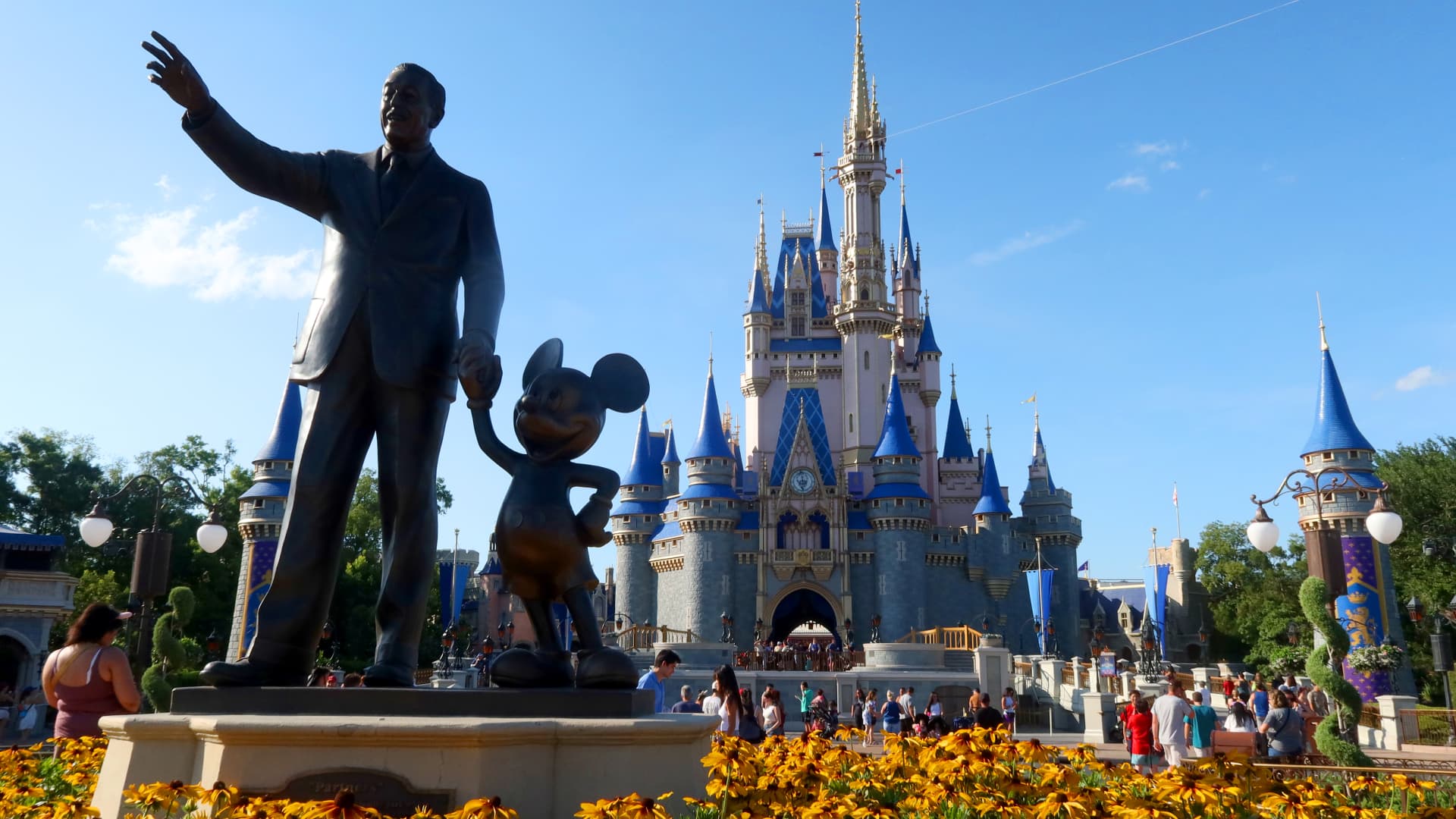
You must be logged in to post a comment Login